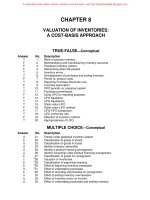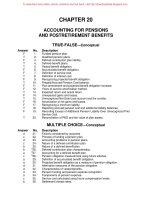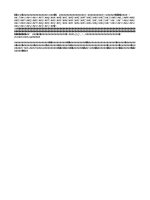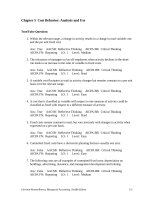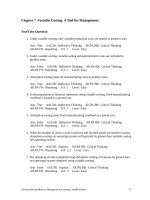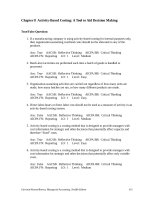Test bank managerial accounting 12e garrison
Bạn đang xem bản rút gọn của tài liệu. Xem và tải ngay bản đầy đủ của tài liệu tại đây (2.54 MB, 860 trang )
To download more slides, ebook, solutions and test bank, visit
Chapter 1 Managerial Accounting and the Business Environment
True/False Questions
1. Although financial and managerial accounting differ in many ways, they are similar in
that both rely on the same underlying financial data.
Answer: True Level: Medium LO: 1
2. Managerial accounting is a branch of financial accounting and serves essentially the
same purposes as financial accounting.
Answer: False Level: Medium LO: 1
3. Managerial accounting places greater emphasis on the future than financial
accounting, which is primarily concerned with the past.
Answer: True Level: Easy LO: 1
4. Managerial accounting is not needed in a non-profit or governmental organization.
Answer: False Level: Easy LO: 1
5. When carrying out their planning activities, managers select a course of action and
specify how the action will be implemented.
Answer: True Level: Easy LO: 2
6. When carrying out their planning activities, managers obtain feedback to ensure that
the plan is actually carried out and is appropriately modified as circumstances change.
Answer: False Level: Medium LO: 2
7. The controller occupies a line position in an organization.
Answer: False Level: Easy LO: 2
8. Decentralization means the delegation of decision-making authority throughout an
organization by allowing managers at various operating levels to make key decisions
relating to their own area of responsibility.
Answer: True Level: Easy LO: 2
Garrison, Managerial Accounting, 12th Edition
3
To download more slides, ebook, solutions and test bank, visit
Chapter 1 Managerial Accounting and the Business Environment
9. A firm's organization chart will normally show both the formal and informal lines of
reporting and communication.
Answer: False Level: Easy LO: 2
10. The Chief Financial Officer of an organization is responsible for ensuring that line
operations run smoothly.
Answer: False Level: Medium LO: 2
11. Traditionally, companies have maintained large amounts of raw materials, work in
process, and finished goods inventories to act as buffers so that operations can proceed
smoothly even if there are unanticipated disruptions.
Answer: True Level: Medium LO: 3
12. Process Reengineering is generally considered to be a more radical approach to
improvement than Total Quality Management.
Answer: True Level: Easy LO: 3
13. Process Reengineering emphasizes a team approach involving front-line workers,
whereas Total Quality Management is usually implemented using outside specialists
and is imposed from above.
Answer: False Level: Medium LO: 3
14. If ethical standards were not generally followed, one of the results would probably be
fewer goods and services available in the marketplace.
Answer: True Level: Medium LO: 4
15. The Standards of Ethical Conduct for Management Accountants promulgated by the
Institute of Management Accountants specifically state that management accountants'
sole ethical responsibility is to not break any laws.
Answer: False Level: Easy LO: 4
4
Garrison, Managerial Accounting, 12th Edition
To download more slides, ebook, solutions and test bank, visit
Chapter 1 Managerial Accounting and the Business Environment
Multiple Choice Questions
16. Management accounting focuses primarily on providing data for:
A) internal uses by managers.
B) external uses by stockholders and creditors.
C) external uses by the Internal Revenue Service.
D) external uses by the Securities and Exchange Commission.
Answer: A Level: Easy LO: 1
17. Managerial accounting:
A) is more future oriented than financial accounting.
B) tends to summarize information more than financial accounting
C) is primarily concerned with providing information to external users.
D) is more concerned with precision than timeliness.
Answer: A Level: Easy LO: 1
18. Compared to financial accounting, managerial accounting places more emphasis on:
A) the flexibility of information.
B) the precision of information.
C) the timeliness of information.
D) both A and C above.
Answer: D Level: Easy LO: 1
19. The function of management that compares planned results to actual results is known
as:
A) planning.
B) directing and motivating.
C) controlling.
D) decision making.
Answer: C Level: Easy LO: 2
20. Which of the functions of management involves overseeing day-to-day activities?
A) Planning
B) Directing and motivating
C) Controlling
D) Decision making
Answer: B Level: Easy LO: 2
Garrison, Managerial Accounting, 12th Edition
5
To download more slides, ebook, solutions and test bank, visit
Chapter 1 Managerial Accounting and the Business Environment
21. Which of the following is not one of the three basic activities of a manager?
A) Planning
B) Controlling
C) Directing and motivating
D) Compiling management accounting reports
Answer: D Level: Easy LO: 2
22. The delegation of decision making to lower levels in an organization is known as:
A) the planning and control cycle.
B) controlling.
C) decentralization.
D) none of these.
Answer: C Level: Easy LO: 2
23. Which of the following statements are false concerning line and staff functions?
I. Persons occupying staff functions have authority over persons occupying line
functions.
II. Both line and staff functions are depicted on the organization chart.
III. Line functions are directly related to the basic objectives of an organization.
A)
B)
C)
D)
Only I
Only II
Only I and II
I, II, and III
Answer: A Level: Medium LO: 2
24. Which of following would normally be found on a manufacturing company's
organization chart?
A) the layout of the factory assembly lines
B) a list of the materials needed to produce each of the company's products
C) the informal lines of reporting and communication
D) none of the above
Answer: D Level: Easy LO: 2
6
Garrison, Managerial Accounting, 12th Edition
To download more slides, ebook, solutions and test bank, visit
Chapter 1 Managerial Accounting and the Business Environment
25. For a hospital, what type of position (line or staff) is each of the following?
A)
B)
C)
D)
Emergency Room Manager Human Resources (Personnel) Manager
Staff
Staff
Staff
Line
Line
Staff
Line
Line
Answer: C Level: Easy LO: 2
26. A detailed financial plan for the future is known as a:
A) budget.
B) performance report.
C) organization chart.
D) segment.
Answer: A Level: Easy LO: 2
27. A performance report is:
A) a detailed report comparing budgeted data to actual data for a specific time period.
B) a formal statement of plans for the upcoming period.
C) required to be filed monthly by the Securities and Exchange Commission.
D) not used in decentralized organizations.
Answer: A Level: Easy LO: 2
28. A clustering of two or more machines at a single workstation is referred to as:
A) a manufacturing cell.
B) an activity center.
C) a functional layout.
D) a setup.
Answer: A Level: Medium LO: 3
29. A focused factory is:
A) a factory that makes only a single product.
B) a factory that performs a single step in the production process and subcontracts the
other steps.
C) a plant layout in which all machines needed to make a particular product are
brought together in one location.
D) required to bid for defense contracts.
Answer: C Level: Easy LO: 3
Garrison, Managerial Accounting, 12th Edition
7
To download more slides, ebook, solutions and test bank, visit
Chapter 1 Managerial Accounting and the Business Environment
30. Large work in process inventories:
A) are essential for efficient operations.
B) reduce defect rates.
C) increase throughput time.
D) are a key part of Just-In-Time systems.
Answer: C Level: Medium LO: 3
31. Ideally, how many units should be produced in a just-in-time manufacturing system?
A) budgeted customer demand for the current week.
B) budgeted customer demand for the following week.
C) actual customer demand for the current week.
D) maximum production capacity for the current week.
Answer: C Level: Medium LO: 3
32. After careful planning, Jammu Manufacturing Corporation has decided to switch to a
just-in-time inventory system. At the beginning of this switch, Jammu has 30 units of
product in inventory. Jammu has 2,000 labor hours available in the first month of this
switch. These hours could produce 500 units of product. Customer demand for this
first month is 400 units. If just-in-time principles are correctly followed, how many
units should Jammu plan to produce in the first month of the switch?
A) 370
B) 400
C) 430
D) 470
Answer: A Level: Medium LO: 3
33. Process Reengineering includes all of the following steps except:
A) constructing a diagram flowcharting the current process.
B) redesigning the process.
C) elimination of non-value-added activities.
D) elimination of all constraints.
Answer: D Level: Hard LO: 3
8
Garrison, Managerial Accounting, 12th Edition
To download more slides, ebook, solutions and test bank, visit
Chapter 1 Managerial Accounting and the Business Environment
34. According to the Theory of Constraints, improvement efforts should usually be
focused on:
A) work centers that are not constraints.
B) the work center that is the constraint.
C) the work center with the highest total cost.
D) the work center with the most obsolete equipment.
Answer: B Level: Medium LO: 3
35. Which of the following is true regarding the theory of constraints?
A) The theory of constraints does not apply to companies with multiple products
because of capacity measurement difficulties.
B) In any profit-seeking company, there must be at least one constraint.
C) Constraints or bottlenecks stop organizations from selling an infinite number of
units or services.
D) both B and C above.
Answer: D Level: Medium LO: 3
36. Pizza World makes forty-three kinds of pizza for takeout and delivery. Which of the
following could be the constraint at Pizza World?
A) the person who makes the pizza crust.
B) the person who puts toppings on the pizzas.
C) the pizza oven.
D) any of the above could be the constraint.
Answer: D Level: Medium LO: 3
37. The Standards of Ethical Conduct for Management Accountants developed by the
Institute of Management Accountants contain a policy regarding confidentiality that
requires management accountants to refrain from disclosing confidential information
acquired in the course of their work:
A) except when authorized by management.
B) in all situations.
C) except when authorized by management, unless legally obligated to do so.
D) in all cases not prohibited by law.
Answer: C Level: Hard LO: 4
Garrison, Managerial Accounting, 12th Edition
9
To download more slides, ebook, solutions and test bank, visit
Chapter 1 Managerial Accounting and the Business Environment
38. Wide-spread adherence to ethical standards in an advanced market economy tends to
result in all of the following except:
A) higher prices.
B) higher quality goods and services.
C) greater variety of goods and services available for sale.
D) safer products.
Answer: A Level: Medium LO: 4
39. The Institute of Management Accountants (IMA) has developed ethical standards for
management accountants. What four categories has the IMA classified these standards
into?
A) Reliability, Objectivity, Commitment, and Competence
B) Objectivity, Integrity, Commitment, and Confidentiality
C) Observation, Integrity, Closure, and Competence
D) Competence, Objectivity, Integrity, and Confidentiality
E) Reliability, Understandability, Flexibility, and Integrity
Answer: D Level: Medium LO: 4
40. Samantha Galloway is a managerial accountant in the accounting department of
Mustang Industries, Inc. Samantha has just discovered evidence that some of the
corporation's marketing managers have been wrongfully inflating their expense reports
in order to obtain higher reimbursements from the firm. According to the Institute of
Management Accountants' Standards of Ethical Conduct, what should Samantha do
upon discovering this evidence?
A) notify the controller.
B) notify the marketing managers involved.
C) notify the president of the corporation.
D) ignore the evidence because she is not part of the Marketing Department.
Answer: A Level: Hard LO: 4
10
Garrison, Managerial Accounting, 12th Edition
To download more slides, ebook, solutions and test bank, visit
Chapter 2 Cost Terms, Concepts, and Classifications
True/False Questions
1. Manufacturing overhead is an indirect cost with respect to units of product.
Answer: True Level: Medium LO: 1
2. Depreciation on office equipment would not be included in the cost of goods
manufactured.
Answer: True Level: Easy LO: 2,4
3. Rent on a factory building used in the production process would be classified as a
period cost and as a fixed cost.
Answer: False Level: Medium LO: 2,5
4. Period costs are found only in manufacturing companies, not in merchandising
companies.
Answer: False Level: Medium LO: 2
5. Depreciation on equipment a company uses in its selling and administrative activities
would be classified as a product cost.
Answer: False Level: Medium LO: 2
6. If the finished goods inventory increases between the beginning and the end of a
period, then the cost of goods manufactured is smaller than the cost of goods sold.
Answer: False Level: Hard LO: 3,4
7. The cost of goods manufactured is calculated by adding the amount of work in process
at the end of the year to the cost of raw materials used, direct labor worked, and
manufacturing overhead incurred for the year and then subtracting work in process at
the beginning of the year.
Answer: False Level: Medium LO: 4
8. A publisher that sells its books through agents who are paid a constant percentage
commission on each book sold would classify the commissions as a fixed cost.
Answer: False Level: Medium LO: 5
Garrison, Managerial Accounting, 12th Edition
15
To download more slides, ebook, solutions and test bank, visit
Chapter 2 Cost Terms, Concepts, and Classifications
9. Variable costs per unit are affected by changes in activity.
Answer: False Level: Easy LO: 5
10. A cost is either direct or indirect. The classification will not change if the cost object
changes.
Answer: False Level: Medium LO: 6
11. The amount that a manufacturing company could earn by renting unused portions of
its warehouse is an example of an opportunity cost.
Answer: True Level: Easy LO: 7
12. Labor fringe benefits may be charged to direct labor or manufacturing overhead while
overtime premiums paid usually are considered a part of manufacturing overhead.
Answer: True Level: Easy LO: 8 Appendix: 2A
13. The cost of idle time should be charged as direct labor of the job that is in process
when the breakdown occurs.
Answer: False Level: Medium LO: 8 Appendix: 2A
14. Internal failure costs result from identification of defects during the appraisal process.
Such costs may include scrap, rejected products, rework, and downtime.
Answer: True Level: Easy LO: 9 Appendix: 2B
15. ISO 9000 certification is relatively easy to achieve because little documentation on
quality control procedures is needed.
Answer: False Level: Easy LO: 11 Appendix: 2B
16
Garrison, Managerial Accounting, 12th Edition
To download more slides, ebook, solutions and test bank, visit
Chapter 2 Cost Terms, Concepts, and Classifications
Multiple Choice Questions
16. Indirect labor is a part of:
A) Prime cost.
B) Conversion cost.
C) Period cost.
D) Nonmanufacturing cost.
Answer: B Level: Medium LO: 1,2 Source: CPA, adapted
17. The cost of lubricants used to grease a production machine in a manufacturing
company is an example of a(n):
A) period cost.
B) direct material cost.
C) indirect material cost.
D) none of the above.
Answer: C Level: Easy LO: 1,2
18. The salary paid to the president of King Company would be classified on the income
statement as a(n):
A) administrative expense.
B) direct labor cost.
C) manufacturing overhead cost.
D) selling expense.
Answer: A Level: Easy LO: 1
19. Direct labor cost is a part of:
A)
B)
C)
D)
Conversion cost Prime cost
No
No
No
Yes
Yes
Yes
Yes
No
Answer: C Level: Easy LO: 1 Source: CPA, adapted
Garrison, Managerial Accounting, 12th Edition
17
To download more slides, ebook, solutions and test bank, visit
Chapter 2 Cost Terms, Concepts, and Classifications
20. Direct material cost is a:
A)
B)
C)
D)
Conversion cost Prime cost
No
No
No
Yes
Yes
Yes
Yes
No
Answer: B Level: Medium LO: 1 Source: CPA, adapted
21. Prime cost and conversion cost share what common element of total cost?
A) Direct materials.
B) Direct labor.
C) Variable overhead.
D) Fixed overhead.
Answer: B Level: Easy LO: 1 Source: CPA, adapted
22. Prime cost consists of:
A) direct labor and manufacturing overhead.
B) direct materials and manufacturing overhead.
C) direct materials and direct labor.
D) direct materials, direct labor and manufacturing overhead.
Answer: C Level: Easy LO: 1
23. Wages paid to a timekeeper in a factory are a:
A)
B)
C)
D)
Prime cost Conversion cost
Yes
No
Yes
Yes
No
No
No
Yes
Answer: D Level: Medium LO: 1 Source: CPA, adapted
24. Property taxes on a company's factory building would be classified as a(n):
A) product cost.
B) opportunity cost.
C) period cost.
D) variable cost.
Answer: A Level: Easy LO: 2,5,7
18
Garrison, Managerial Accounting, 12th Edition
To download more slides, ebook, solutions and test bank, visit
Chapter 2 Cost Terms, Concepts, and Classifications
25. Depreciation on a personal computer used in the marketing department of a
manufacturing firm would be classified as:
A) a product cost that is fixed with respect to the company's output.
B) a period cost that is fixed with respect to the company's output.
C) a product cost that is variable with respect to the company's output.
D) a period cost that is fixed with respect to the company's output.
Answer: B Level: Medium LO: 2,5
26. The nursing station on the fourth floor of Central Hospital is responsible for the care
of patients who have undergone orthopedic surgery. The costs of drugs administered
by the nursing station to patients would be classified as:
A) direct costs of the patients.
B) indirect costs of the patients.
C) overhead costs of the nursing station.
D) period costs of the hospital.
Answer: A Level: Hard LO: 2,6
27. All of the following would be classified as product costs except:
A) property taxes on production equipment.
B) insurance on factory machinery.
C) salaries of the advertising staff.
D) wages of machine operators.
Answer: C Level: Easy LO: 2
28. Product costs appear on the balance sheet:
A) only if goods are partially completed at the end of the period.
B) only if goods are unsold at the end of a period.
C) only if goods are partially completed or are unsold at the end of a period.
D) only in merchandising firms.
Answer: C Level: Medium LO: 2
Garrison, Managerial Accounting, 12th Edition
19
To download more slides, ebook, solutions and test bank, visit
Chapter 2 Cost Terms, Concepts, and Classifications
29. Ross Corporation shipped finished goods to a customer on credit, but the sale was not
recorded and the costs of the finished goods were incorrectly included on the period's
balance sheet as part of the finished goods inventory. Which one of the following
statements is correct concerning the effects of this error?
A) Accounts receivable was not affected, inventory was overstated, sales were
understated, and cost of goods sold was understated.
B) Accounts receivable was understated, inventory was not affected, sales were
understated, and cost of goods sold was understated.
C) Accounts receivable was understated, inventory was overstated, sales were
understated, and cost of goods sold was overstated.
D) Accounts receivable was understated, inventory was overstated, sales were
understated, and cost of goods sold was understated.
Answer: D Level: Easy LO: 3 Source: CMA, adapted
30. Data for Cost A and Cost B are as follows:
Number of
Units
Produced
Unit Cost Total Cost
Cost A
1
10
100
1,000
?
?
?
?
$10
$100
$1,000
$10,000
1
10
100
1,000
$5,000
$500
$50
$5
?
?
?
?
Cost B
Which of the above best describes the behavior of Costs A and B?
A) Cost A is fixed, Cost B is variable.
B) Cost A is variable, Cost B is fixed.
C) Both Cost A and Cost B are variable.
D) Both Cost A and Cost B are fixed.
Answer: B Level: Medium LO: 5
20
Garrison, Managerial Accounting, 12th Edition
To download more slides, ebook, solutions and test bank, visit
Chapter 2 Cost Terms, Concepts, and Classifications
31. Fixed costs expressed on a per unit basis:
A) will increase with increases in activity.
B) will decrease with increases in activity.
C) are not affected by activity.
D) should be ignored in making decisions since they cannot change.
Answer: B Level: Medium LO: 5
32. The costs of staffing and operating the accounting department at Central Hospital
would be considered by the Department of Surgery to be:
A) direct costs.
B) indirect costs.
C) incremental costs.
D) opportunity costs.
Answer: B Level: Hard LO: 6,7
33. A cost incurred in the past that is not relevant to any current decision is classified as
a(n):
A) period cost.
B) opportunity cost.
C) sunk cost.
D) differential cost.
Answer: C Level: Easy LO: 7
34. Differential costs can:
A) only be fixed costs.
B) only be variable costs.
C) be either fixed or variable.
D) be incremental but not decremental.
Answer: C Level: Easy LO: 7
35. John Johnson decided to leave his former job where he earned $12 per hour to go to a
new job where he will earn $13 per hour. In the decision process, the former wage of
$12 per hour would be classified as a(n):
A) sunk cost.
B) direct cost.
C) fixed cost.
D) opportunity cost.
Answer: D Level: Easy LO: 7
Garrison, Managerial Accounting, 12th Edition
21
To download more slides, ebook, solutions and test bank, visit
Chapter 2 Cost Terms, Concepts, and Classifications
36. The term that refers to costs incurred in the past that are not relevant to a decision is:
A) marginal cost.
B) indirect cost.
C) period cost.
D) sunk cost.
Answer: D Level: Easy LO: 7
37. Lathe operators at KF Manufacturing are hourly employees who are paid time and a
half for hours worked in excess of 40 hours per week. Lester is a lathe operator who
worked 45 hours during the current week and had no idle time. The correct accounting
for the amounts paid to Lester would be:
A) charge only the overtime premium earned to the overhead account.
B) charge the hourly wage earned plus the overtime premium earned to the overhead
account.
C) charge only the overtime premium earned to the direct labor cost for the project
Lester was working on when the overtime was incurred.
D) charge the hourly wage earned plus the overtime premium earned to the direct
labor cost for the project Lester was working on when the overtime was incurred.
Answer: A Level: Medium LO: 8 Appendix: 2A
38. The controller of the recently organized Crandall Company is considering the two
methods listed below for accounting for labor fringe benefits. Which of the two
methods is considered acceptable?
Method A:
Treat all labor fringe benefits as indirect labor by adding them in
total to manufacturing overhead.
Method B:
Treat labor fringe benefits that relate to direct labor as additional
direct labor cost and fringe benefits relating to indirect labor as
part of manufacturing overhead.
A)
B)
C)
D)
Only Method A is acceptable.
Only Method B is acceptable.
Both Method A and Method B are acceptable.
Neither Method A nor Method B is acceptable; labor fringe benefits should be
treated as period expenses and should be charged off as incurred.
Answer: C Level: Medium LO: 8 Appendix: 2A
22
Garrison, Managerial Accounting, 12th Edition
To download more slides, ebook, solutions and test bank, visit
Chapter 2 Cost Terms, Concepts, and Classifications
39. Which of the following would be classified as a prevention cost on a quality cost
report?
A) Disposal of defective products.
B) Net cost of spoilage.
C) Depreciation of test equipment.
D) Technical support provided to suppliers.
Answer: D Level: Medium LO: 9,10 Appendix: 2B
40. Which of the following would be classified as a prevention cost on a quality cost
report?
A) Debugging software errors.
B) Quality training.
C) Test and inspection of incoming materials.
D) Cost of field servicing and handling complaints.
Answer: B Level: Medium LO: 9,10 Appendix: 2B
41. Which of the following would be classified as a prevention cost on a quality cost
report?
A) Supplies used in testing and inspection.
B) Debugging software errors.
C) Quality improvement projects.
D) Lost sales arising from a reputation for poor quality.
Answer: C Level: Medium LO: 9,10 Appendix: 2B
42. Which of the following would be classified as an appraisal cost on a quality cost
report?
A) Final product testing and inspection.
B) Net cost of spoilage.
C) Repairs and replacements beyond the warranty period.
D) Rework labor and overhead.
Answer: A Level: Medium LO: 9,10 Appendix: 2B
Garrison, Managerial Accounting, 12th Edition
23
To download more slides, ebook, solutions and test bank, visit
Chapter 2 Cost Terms, Concepts, and Classifications
43. Which of the following would be classified as an appraisal cost on a quality cost
report?
A) Quality improvement projects.
B) Supplies used in testing and inspection.
C) Audits of the effectiveness of the quality system.
D) Quality data gathering, analysis, and reporting.
Answer: B Level: Medium LO: 9,10 Appendix: 2B
44. Which of the following would be classified as an appraisal cost on a quality cost
report?
A) Maintenance of test equipment.
B) Re-entering data because of keying errors.
C) Debugging software errors.
D) Warranty repairs and replacements.
Answer: A Level: Medium LO: 9,10 Appendix: 2B
45. Which of the following would be classified as an internal failure cost on a quality cost
report?
A) Quality improvement projects.
B) Supervision of testing and inspection activities.
C) Debugging software errors.
D) Warranty repairs and replacements.
Answer: C Level: Medium LO: 9,10 Appendix: 2B
46. Which of the following would be classified as an internal failure cost on a quality cost
report?
A) Final product testing and inspection.
B) Warranty repairs and replacements.
C) Depreciation of test equipment.
D) Debugging software errors.
Answer: D Level: Medium LO: 9,10 Appendix: 2B
24
Garrison, Managerial Accounting, 12th Edition
To download more slides, ebook, solutions and test bank, visit
Chapter 2 Cost Terms, Concepts, and Classifications
47. Which of the following would be classified as an internal failure cost on a quality cost
report?
A) Rework labor and overhead.
B) Cost of field servicing and handling complaints.
C) Technical support provided to suppliers.
D) Lost sales arising from a reputation for poor quality.
Answer: A Level: Medium LO: 9,10 Appendix: 2B
48. Which of the following would be classified as an external failure cost on a quality cost
report?
A) Reentering data because of keying errors.
B) Customer returns arising from quality problems.
C) Test and inspection of in-process goods.
D) Rework labor and overhead.
Answer: B Level: Medium LO: 9,10 Appendix: 2B
49. Which of the following would be classified as an external failure cost on a quality cost
report?
A) Repairs and replacements beyond the warranty period.
B) Technical support provided to suppliers.
C) Quality improvement projects.
D) Rework labor and overhead.
Answer: A Level: Medium LO: 9,10 Appendix: 2B
50. Which of the following would be classified as an external failure cost on a quality cost
report?
A) Final product testing and inspection.
B) Disposal of defective products.
C) Supervision of testing and inspection activities.
D) Cost of field servicing and handling complaints.
Answer: D Level: Medium LO: 9,10 Appendix: 2B
51. Inspection of products would be classified as a(n):
A) prevention cost.
B) appraisal cost.
C) internal failure cost.
D) external failure cost.
Answer: B Level: Medium LO: 9 Appendix: 2B
Garrison, Managerial Accounting, 12th Edition
25
To download more slides, ebook, solutions and test bank, visit
Chapter 2 Cost Terms, Concepts, and Classifications
52. The cost of warranty repairs would be classified as a(n):
A) prevention cost.
B) appraisal cost.
C) internal failure cost.
D) external failure cost.
Answer: D Level: Easy LO: 9 Appendix: 2B
53. The cost of quality training would be classified as a(n):
A) prevention cost.
B) appraisal cost.
C) internal failure cost.
D) external failure cost.
Answer: A Level: Easy LO: 9 Appendix: 2B
54. The cost of labor time required to rework defective units would be classified as a(n):
A) prevention cost.
B) appraisal cost.
C) internal failure cost.
D) external failure cost.
Answer: C Level: Easy LO: 9 Appendix: 2B
55. Which of the following is (are) categorized as internal failure cost(s)?
I. Rework.
II. Responding to customer complaints.
III. Statistical quality control procedures.
A)
B)
C)
D)
I only.
II only.
III only.
I, II, and III.
Answer: A Level: Medium LO: 9 Source: CPA, adapted Appendix: 2B
26
Garrison, Managerial Accounting, 12th Edition
To download more slides, ebook, solutions and test bank, visit
Chapter 2 Cost Terms, Concepts, and Classifications
56. Adolphson Corporation has provided the following summary of its quality cost report
for the last two years:
Summary of Quality Cost Report
(in thousands)
Prevention costs ..........................
Appraisal costs ...........................
Internal failure costs ...................
External failure costs ..................
Total quality costs ......................
This Year Last Year
$ 300
$ 200
315
210
114
190
1,200
621
$1,350
$1,800
% Change
+50
+50
-40
-48
-25
On the basis of this report, which one of the following statements is most likely
correct?
A) An increase in prevention and appraisal costs resulted in fewer defects, and
therefore, resulted in a decrease in internal and external failure costs.
B) A decrease in internal and external failure costs resulted in less need for
prevention and appraisal costs.
C) Quality costs such as scrap and rework decreased by 48%.
D) Quality costs such as returns and repairs under warranty decreased by 40%.
Answer: A Level: Medium LO: 10 Source: CMA, adapted Appendix: 2B
57. The following costs were incurred in January:
Direct materials .............................
Direct labor ....................................
Manufacturing overhead................
Selling expenses ............................
Administrative expenses................
$33,000
$28,000
$69,000
$16,000
$21,000
Conversion costs during the month totaled:
A) $97,000
B) $167,000
C) $102,000
D) $61,000
Answer: A Level: Medium LO: 1,2
Garrison, Managerial Accounting, 12th Edition
27
To download more slides, ebook, solutions and test bank, visit
Chapter 2 Cost Terms, Concepts, and Classifications
58. The following costs were incurred in February:
Direct materials .........................
Direct labor ...............................
Manufacturing overhead ...........
Selling expenses ........................
Administrative expenses ...........
$43,000
$16,000
$37,000
$17,000
$26,000
Conversion costs during the month totaled:
A) $59,000
B) $80,000
C) $53,000
D) $139,000
Answer: C Level: Medium LO: 1,2
59. The following costs were incurred in March:
Direct materials .............................
Direct labor ....................................
Manufacturing overhead................
Selling expenses ............................
Administrative expenses................
$21,000
$17,000
$67,000
$16,000
$15,000
Conversion costs during the month totaled:
A) $88,000
B) $38,000
C) $136,000
D) $84,000
Answer: D Level: Medium LO: 1,2
28
Garrison, Managerial Accounting, 12th Edition
To download more slides, ebook, solutions and test bank, visit
Chapter 2 Cost Terms, Concepts, and Classifications
60. The following costs were incurred in January:
Direct materials .............................
Direct labor ....................................
Manufacturing overhead................
Selling expenses ............................
Administrative expenses................
$39,000
$26,000
$21,000
$14,000
$27,000
Prime costs during the month totaled:
A) $86,000
B) $65,000
C) $47,000
D) $127,000
Answer: B Level: Medium LO: 1,2
61. The following costs were incurred in February:
Direct materials .............................
Direct labor ....................................
Manufacturing overhead................
Selling expenses ............................
Administrative expenses................
$39,000
$18,000
$14,000
$13,000
$29,000
Prime costs during the month totaled:
A) $71,000
B) $32,000
C) $113,000
D) $57,000
Answer: D Level: Medium LO: 1,2
Garrison, Managerial Accounting, 12th Edition
29
To download more slides, ebook, solutions and test bank, visit
Chapter 2 Cost Terms, Concepts, and Classifications
62. The following costs were incurred in March:
Direct materials .............................
Direct labor ....................................
Manufacturing overhead................
Selling expenses ............................
Administrative expenses................
$39,000
$24,000
$14,000
$11,000
$19,000
Prime costs during the month totaled:
A) $63,000
B) $107,000
C) $38,000
D) $77,000
Answer: A Level: Medium LO: 1,2
63. Aable Company's manufacturing overhead is 20% of its total conversion costs. If
direct labor is $45,000 and if direct materials are $53,000, the manufacturing overhead
is:
A) $11,250
B) $13,250
C) $180,000
D) $24,500
Answer: A Level: Hard LO: 1
64. Abair Company's manufacturing overhead is 20% of its total conversion costs. If
direct labor is $38,000 and if direct materials are $35,000, the manufacturing overhead
is:
A) $18,250
B) $9,500
C) $8,750
D) $152,000
Answer: B Level: Hard LO: 1
30
Garrison, Managerial Accounting, 12th Edition
To download more slides, ebook, solutions and test bank, visit
Chapter 2 Cost Terms, Concepts, and Classifications
65. Abbey Company's manufacturing overhead is 60% of its total conversion costs. If
direct labor is $35,000 and if direct materials are $55,000, the manufacturing overhead
is:
A) $135,000
B) $23,333
C) $82,500
D) $52,500
Answer: D Level: Hard LO: 1
66. During the month of January, direct labor cost totaled $17,000 and direct labor cost
was 60% of prime cost. If total manufacturing costs during January were $82,000, the
manufacturing overhead was:
A) $11,333
B) $53,667
C) $28,333
D) $65,000
Answer: B Level: Hard LO: 1
67. During the month of February, direct labor cost totaled $13,000 and direct labor cost
was 40% of prime cost. If total manufacturing costs during February were $80,000,
the manufacturing overhead was:
A) $32,500
B) $19,500
C) $67,000
D) $47,500
Answer: D Level: Hard LO: 1
68. During the month of March, direct labor cost totaled $17,000 and direct labor cost was
70% of prime cost. If total manufacturing costs during March were $88,000, the
manufacturing overhead was:
A) $24,286
B) $71,000
C) $63,714
D) $7,286
Answer: C Level: Hard LO: 1
Garrison, Managerial Accounting, 12th Edition
31
